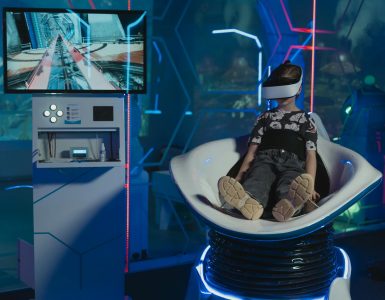Remember those old sci-fi flicks? Flying cars, robots doing our chores, talking to people across the globe instantly? Sound like fantasy? Not so much anymore. While we haven’t quite reached the utopian (or dystopian, depending on the film) futures depicted, a lot of what once seemed like pure science fiction is creeping into our everyday reality at an astonishing pace. It’s like science fiction is writing the script for our future, one technological leap at a time.
The Rise of the Machines (and AI isn’t just a movie villain anymore)
Artificial Intelligence (AI) isn’t just some sentient computer threatening to take over the world anymore (though some of us still keep a wary eye on rogue algorithms). AI is powering everything from your phone’s voice assistant to self-driving cars, and it’s rapidly improving. We’ve moved beyond the clunky robots of yesteryear. We’re seeing incredible advancements in robotics, with machines capable of performing complex surgeries, exploring dangerous environments, and even exhibiting rudimentary forms of emotional intelligence. The “Jetsons” robot maid is still a ways off, but AI-powered cleaning robots are already here, improving constantly.
Machine learning, a subset of AI, is enabling systems to learn and adapt without explicit programming. This means our tech is getting smarter, faster, and more intuitive. Think of Netflix recommending your next binge-worthy show, or Spotify creating personalized playlists. These are AI-powered systems learning our preferences and adapting to them in real-time. The future promises even more personalized experiences, from customized education to tailored healthcare. And yes, that also means more targeted advertising, so brace yourselves.
Virtual Reality: Stepping into the Metaverse (it’s not just a gaming thing)
Remember those bulky VR headsets from the 90s that promised a virtual world but delivered mostly nausea? Those were the early days. Today, VR technology is evolving at an incredible rate. We’re seeing increasingly realistic and immersive experiences, used not only for gaming but also for training simulations, architectural visualizations, and even therapy. The “Metaverse,” a persistent, shared virtual world, is still largely a concept, but the building blocks are firmly in place, with platforms like VRchat paving the way for a future where we’ll be able to interact with each other and digital environments in entirely new ways.
Augmented reality (AR) is another game-changer. Unlike VR, which immerses you in a completely digital world, AR overlays digital information onto the real world. Think Pokemon Go, but on a much larger scale. AR apps are already being used in everything from navigation and shopping to healthcare and manufacturing. Imagine surgeons using AR overlays to guide their incisions, architects visualizing designs in real-time, or tourists accessing information about historical landmarks just by pointing their phones at them. This is a future being built right now.
Biotech and the Body Electric: More Than Just Medical Marvels
Sci-fi has long explored the possibilities of manipulating the human body and extending life. Today, that future is closer than ever. Genetic engineering, nanotechnology, and regenerative medicine are blurring the lines between science fiction and reality. We’re seeing gene therapies offering cures for previously incurable diseases, personalized medicine tailored to an individual’s unique genetic makeup, and incredible advances in prosthetic technology that enable amputees to regain lost functionality and even sense touch.
3D-printed organs offer the potential to eliminate organ transplantation waiting lists. Imagine a future where your body’s parts can be printed out and seamlessly integrated, and the fear of organ failure becomes a thing of the past. Nanobots, inspired by countless sci-fi stories, are entering the medical field. They could soon be deployed in the human body to deliver targeted drug therapies, repair damaged tissue, and even monitor health conditions in real-time. While this all sounds futuristic, many of these technologies are in active development and slowly, surely making their way into clinical applications. Sci-Fi's Shadow: Reflections of Reality in a Tech-Fueled Tomorrow
Space Exploration: Reaching for the Stars (and maybe even settling on Mars)
Space travel, once the stuff of dreams, is becoming increasingly accessible. While we’re not quite zipping around the galaxy in warp speed, private companies like SpaceX are making space tourism a reality, and ambitious plans for colonizing Mars are gradually moving from the realm of fantasy into the realm of scientific possibility. Advanced rocket technology and reusable spacecraft are making space missions more affordable and frequent. We already have rovers exploring the surface of Mars, providing invaluable data that informs our understanding of the planet’s potential for human habitation.
The challenge of interstellar travel remains immense, but breakthroughs in propulsion systems, such as fusion power, could revolutionize space exploration. Imagine interstellar probes reaching other star systems within a human lifetime, searching for habitable planets and expanding our understanding of the universe. The sci-fi dream of exploring the cosmos is increasingly becoming a tangible goal, and the next century might witness human colonization of other celestial bodies.
The Ethical Considerations: Navigating the Future Responsibly
As we rapidly approach the realities depicted in our beloved sci-fi narratives, it’s crucial to consider the ethical implications. AI bias, job displacement due to automation, the privacy concerns surrounding data collection and the potential misuse of genetic engineering, and the ethical dilemmas of space colonization are all crucial issues we need to address now. The future depicted in our stories isn’t just about technology, it’s about people. Our future must be one that benefits all of humanity, not just a select few.
Sci-fi has always been a mirror reflecting our hopes, fears, and aspirations. As we move closer to the worlds once confined to the silver screen, it’s time to use that mirror wisely, to ensure that the future we build is a future worthy of the dreams that inspired it.
























Add comment